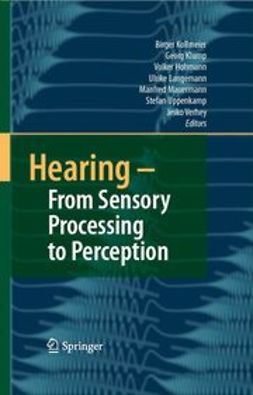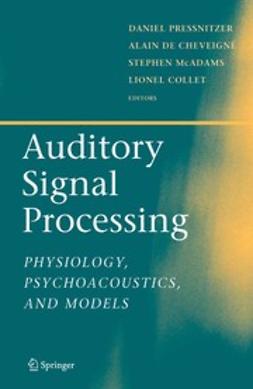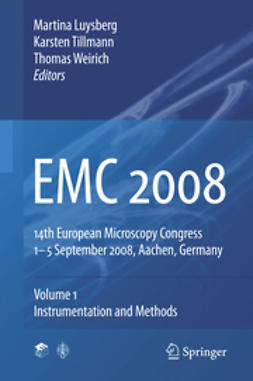Hohmann, Volker
Hearing – From Sensory Processing to Perception
1.Cochlea/Peripheral Processing
1. Influence of Neural Synchrony on the Compound Action Potential, Masking, and the Discrimination of Harmonic Complexes in Several Avian and Mammalian Species
2. A Nonlinear Auditory Filterbank Controlled by Sub-band Instantaneous Frequency Estimates
3. Estimates of Tuning of Auditory Filter Using Simultaneous and Forward Notched-noise Masking
4. A Model of Ventral Cochlear Nucleus Units Based on First Order Intervals
5. The Effect of Reverberation on the Temporal Representation of the F0 of Frequency Swept Harmonic Complexes in the Ventral Cochlear Nucleus
6. Spectral Edges as Optimal Stimuli for the Dorsal Cochlear Nucleus
7. Psychophysical and Physiological Assessment of the Representation of High-frequency Spectral Notches in the Auditory Nerve
2.Pitch
8. Spatio-Temporal Representation of the Pitch of Complex Tones in the Auditory Nerve
9. Virtual Pitch in a Computational Physiological Model
10. Searching for a Pitch Centre in Human Auditory Cortex
11. Imaging Temporal Pitch Processing in the Auditory Pathway
3.Modulation
12. Spatiotemporal Encoding of Vowels in Noise Studied with the Responses of Individual Auditory-Nerve Fibers
13. Role of Peripheral Nonlinearities in Comodulation Masking Release
14. Neuromagnetic Representation of Comodulation Masking Release in the Human Auditory Cortex
15. Psychophysically Driven Studies of Responses to Amplitude Modulation in the Inferior Colliculus: Comparing Single-Unit Physiology to Behavioral Performance
16. Source Segregation Based on Temporal Envelope Structure and Binaural Cues
17. Simulation of Oscillating Neurons in the Cochlear Nucleus: A Possible Role for Neural Nets, Onset Cells, and Synaptic Delays
18. Forward Masking: Temporal Integration or Adaptation?
19. The Time Course of Listening Bands
4.Animal Communication
20. Frogs Communicate with Ultrasound in Noisy Environments
21. The Olivocochlear System Takes Part in Audio-Vocal Interaction
22. Neural Representation of Frequency Resolution in the Mouse Auditory Midbrain
23. Behavioral and Neural Identification of Birdsong under Several Masking Conditions
5.Intensity Representation
24. Near-Threshold Auditory Evoked Fields and Potentials are In Line with the Weber-Fechner Law
25. Brain Activation in Relation to Sound Intensity and Loudness
26. Duration Dependency of Spectral Loudness Summation, Measured with Three Different Experimental Procedures
6.Scene Analysis
27. The Correlative Brain: A Stream Segregation Model
28. Primary Auditory Cortical Responses while Attending to Different Streams
29. Hearing Out Repeating Elements in Randomly Varying Multitone Sequences: A Case of Streaming?
30. The Dynamics of Auditory Streaming: Psychophysics, Neuroimaging, and Modeling
31. Auditory Stream Segregation Based on Speaker Size, and Identification of Size-Modulated Vowel Sequences
32. Auditory Scene Analysis: A Prerequisite for Loudness Perception
33. Modulation Detection Interference as Informational Masking
34. A Paradoxical Aspect of Auditory Change Detection
35. Human Auditory Cortical Processing of Transitions Between ‘Order’ and ‘Disorder’
36. Wideband Inhibition Modulates the Effect of Onset Asynchrony as a Grouping Cue
37. Discriminability of Statistically Independent Gaussian Noise Tokens and Random Tone-Burst Complexes
38. The Role of Rehearsal and Lateralization in Pitch Memory
7.Binaural Hearing
39. Interaural Correlation and Loudness
40. Interaural Phase and Level Fluctuations as the Basis of Interaural Incoherence Detection
41. Logarithmic Scaling of Interaural Cross Correlation: A Model Based on Evidence from Psychophysics and EEG
42. A Physiologically-Based Population Rate Code for Interaural Time Differences (ITDs) Predicts Bandwidth-Dependent Lateralization
43. A p-Limit for Coding ITDs: Neural Responses and the Binaural Display
44. A p-Limit for Coding ITDs: Implications for Binaural Models
45. Strategies for Encoding ITD in the Chicken Nucleus Laminaris
46. Interaural Level Difference Discrimination Thresholds and Virtual Acoustic Space Minimum Audible Angles for Single Neurons in the Lateral Superior Olive
47. Responses in Inferior Colliculus to Dichotic Harmonic Stimuli: The Binaural Integration of Pitch Cues
48. Level Dependent Shifts in Auditory Nerve Phase Locking Underlie Changes in Interaural Time Sensitivity with Interaural Level Differences in the Inferior Colliculus
49. Remote Masking and the Binaural Masking-Level Difference
50. Perceptual and Physiological Characteristics of Binaural Sluggishness
51. Precedence-Effect with Cochlear Implant Simulation
52. Enhanced Processing of Interaural Temporal Disparities at High-Frequencies: Beyond Transposed Stimuli
53. Models of Neural Responses to Bilateral Electrical Stimulation
54. Neural and Behavioral Sensitivities to Azimuth Degrade with Distance in Reverberant Environments
8.Speech and Learning
55. Spectro-temporal Processing of Speech – An Information-Theoretic Framework
56. Articulation Index and Shannon Mutual Information
57. Perceptual Compensation for Reverberation: Effects of ‘Noise-Like’ and ‘Tonal’ Contexts
58. Towards Predicting Consonant Confusions of Degraded Speech
59. The Influence of Masker Type on the Binaural Intelligibility Level Difference
60. Erratum
DRM-restrictions
Printing: not available
Clipboard copying: not available
Nyckelord: SCIENCE / Life Sciences / Biology / General SCI008000
- Författare
- Hohmann, Volker
- Klump, Georg
- Kollmeier, Birger
- Langemann, Ulrike
- Mauermann, Manfred
- Uppenkamp, Stefan
- Verhey, Jesko
- Utgivare
- Springer
- Utgivningsår
- 2007
- Språk
- en
- Utgåva
- 1
- Kategori
- Naturvetenskaper
- Format
- E-bok
- eISBN (PDF)
- 9783540730095











